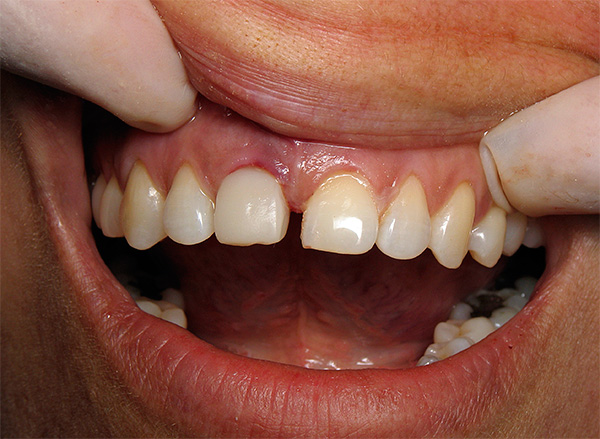
Next you will learn:
- What symptoms are usually associated with implant rejection and when exactly problems can begin;
- How long implants take root and why they are sometimes rejected;
- What sensations are considered normal after an operation just performed, and which are signs of a dangerous inflammation in the implant area;
- What to do if inflammation has begun and whether re-implantation is possible after rejection of the implanted structure.
... And also some other nuances that are interesting and important from a practical point of view regarding the problem of implant rejection.
It should be understood that dental implantation is a rather complicated and to some extent traumatic procedure, the process of tissue healing after which does not always proceed smoothly: swelling, bleeding, and pain due to trauma to the gums and jaw bone are possible. However, all these are normal consequences of surgical intervention, which independently pass after a few days.
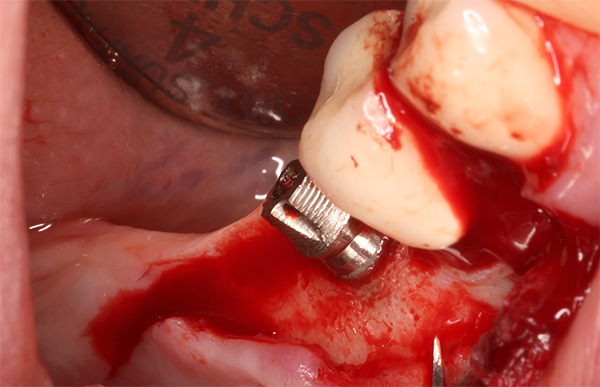
But there are also complications that require surgery by a doctor. And, perhaps, the most unpleasant of them is the rejection of a tooth implant. The first symptoms of this problem are, as a rule, acute pain, structural mobility, the appearance of an unpleasant odor, as well as redness and swelling of the mucous membrane near the outer part of the implant (abutment, plug).
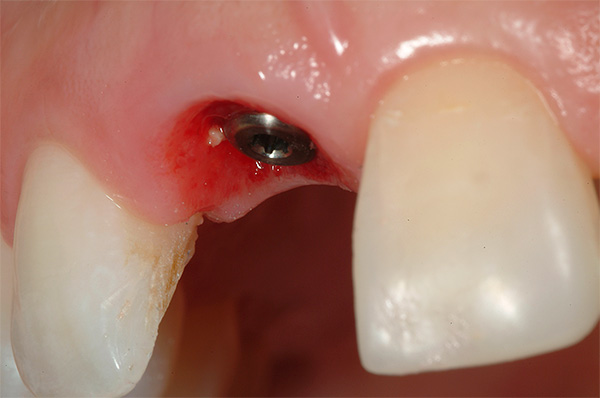
Generally speaking, implant rejection is quite rare today, and patients do not need to pre-tune to an unfavorable outcome of the operation. However, it is necessary to know the characteristic signs of the beginning of rejection, to understand what inflammation can occur under the implant from - it is always useful to be prepared for possible complications in theory in order to prevent their occurrence in practice.
We will talk about this later in more detail.
How long do implants usually take root and when can they be rejected?
The average implant engraftment period is about 2-4 months on the lower jaw and about six months on the upper. This difference is due to the fact that the bones of the lower jaw are better supplied with blood, they are generally larger and stronger, they have a higher chewing load. In addition, the nasal sinus is located above the bone tissue of the upper jaw, the proximity of which often brings additional difficulties when installing implants.
Osteointegration (a medical term for the process of fusion of metal roots with the jawbone) begins immediately after the installation of structures. The timing of engraftment largely depends on the initial state of the jaw bone, as well as on the quality of manufacture and the model of the implant itself.
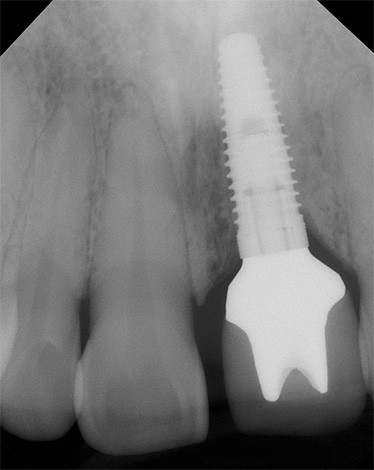
In this case, the method by which the implants were installed in the jaw does not play a special role. Regardless of whether the implants are loaded immediately (for example, with basal implantation), or only after complete fusion with the bone - in both cases, the timing of engraftment does not differ much.
According to statistics, even if implant rejection occurs, in most cases this is observed in the first days after their installation. In other words, if something went wrong, then the first symptoms of a complication, as a rule, are not long in coming.
However, the patient should not lose vigilance even after a successful engraftment of the structure - inflammation after implantation of the teeth followed by rejection of the implant can overtake even after several years of active use.
The photo below shows a corresponding example (inflammation began 10 years after the implant was installed):
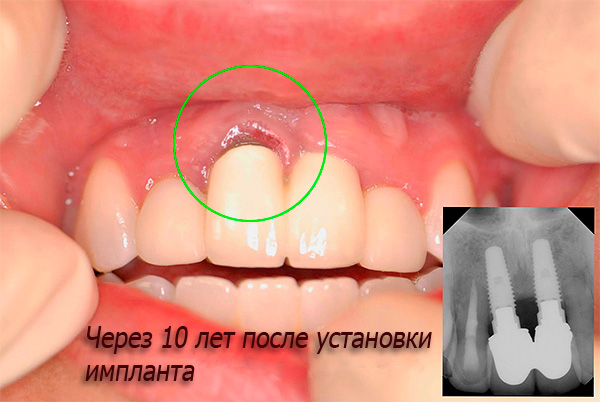
Below we will see what can be done to avoid this adverse outcome.However, before that, let's talk about which sensations are considered normal after dental implantation, and which should be taken as symptoms of peri-implantitis, threatening to develop into implant rejection.
On a note
Periimplantitis is called inflammation of the tissues adjacent to the implant - it can be either soft tissue or bone tissue. If the inflammatory process is not prevented in time, then these tissues will begin to gradually collapse, and the implant will become mobile - in fact, it will be rejected.
Signs of dental implant rejection
After the implantation procedure, you will have to visit your attending physician quite often: the first appointment will take place already 2-3 days after implantation. Such examinations are very important for the timely identification of possible problems (it was mentioned above that in the case of rejection of an implanted structure, this process often occurs in the first days after the operation, so at this stage the monitoring should be especially careful).
The dentist will evaluate the stability of the implant and the condition of the tissues around it. Upon examination, it will become clear how well the structure fuses with the bone, whether there are signs of dangerous inflammation and whether additional intervention is required to prevent unwanted complications.
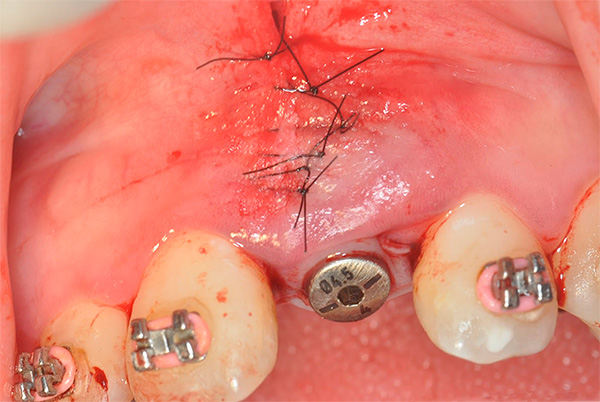
Let's first see what unpleasant symptoms are considered normal after implantation. Since implantation is associated with tissue trauma (even in the case of the use of basal implantation by puncture), after surgery there are always some unpleasant sensations and corresponding external signs:
- swelling of the gums (sometimes the entire cheek swells);
- gum redness;
- sore jaw in the area of the installed implant.
On a note
The aforementioned consequences of surgical intervention normally pass quite quickly, after 3-4 days (maximum - after a week). If you feel severe pain all week, but it does not go away or even intensifies, this is a sure sign that healing is not fast enough. By the way, whether it comes to rejection of the implant, or if everything will work out - this often depends not only on the doctor, but also on the patient’s actions (more on this below).
However, in some cases, for example, with simultaneous bone marrow transplantation, as well as in the presence of acute inflammatory processes in the well, the rehabilitation process may take up to a couple of weeks.
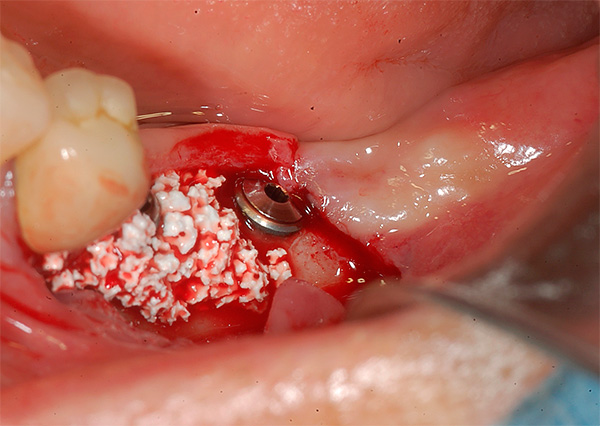
Now we will consider what symptoms indicate a deviation from the course of normal rehabilitation after the installation of implants.
Generally speaking, some symptoms of rejection of a dental implant (or peri-implantitis - inflammation of the tissues around the structure) are largely similar to the usual postoperative consequences. However, they are usually more pronounced and persist for a long time:
- acute pain that does not go away within 1-2 weeks after implantation;
- swelling and redness of the gums, lasting more than 4 days after surgery. Even in the most difficult cases, edema subsides within 3-4 days, so if it persists longer, this is a warning sign;
- prolonged bleeding from the wound, as well as prolonged excretion of the so-called exudate (sacrum). If such discharge lasts more than 7 days - this is not very good;
- mobility of dental implants - here in many cases you can immediately predict that the design is unlikely to take root in the future;
- if there is an unpleasant odor under the plugs mounted on the implants;
- pus from the gums - the abscess can be located next to the implant and communicate with the focus of inflammation through the formation of a fistula, or pus can go directly from under the implant (sometimes there is the appearance of bad breath);
- pain when pressing on the implant is a very characteristic sign that there are serious problems with the integration of the design. In such cases, it is better not to expect that everything will pass by itself and "resolve";
- fever.
All of these signs can indicate a possible rejection of the implant, their appearance at any stage of treatment requires immediate consultation with a specialist.
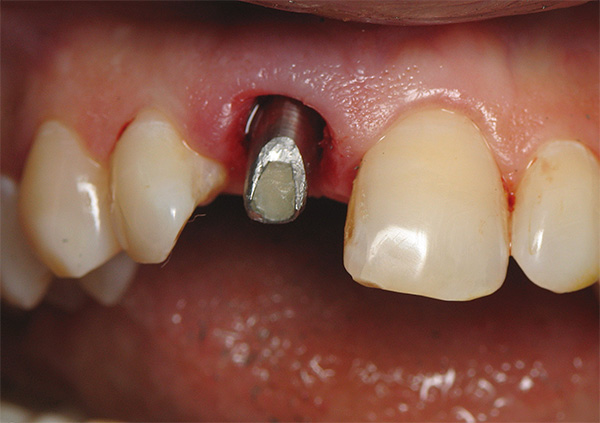
The “inflammation of the implant” of the tooth (or, more precisely, of the tissues surrounding it) can occur without symptoms, especially several years after the structure has been implanted into the bone. The patient may not pay attention to slight soreness and redness of the gums - a pronounced reaction to rejection of the implant may be absent, and inflammation in the meantime will lead to destruction of bone tissue and, as a result, increased mobility of the implant.
This situation is complicated by the fact that subsequently an additional operation to restore the jawbone before re-implantation will be required.
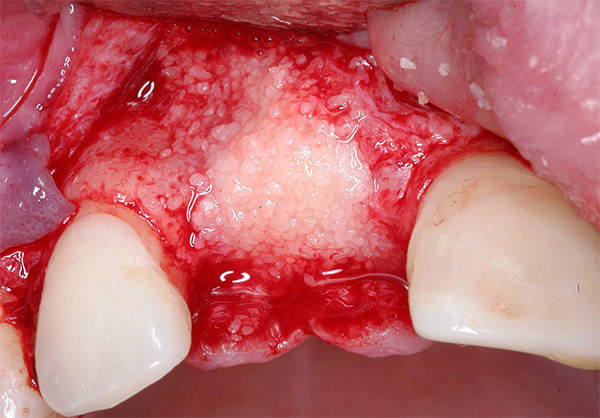
It is interesting:
On average, implants are rejected in no more than 3-5% of all cases, and indicators vary greatly depending on the brand of designs. For example, implants of German or Swiss manufacture successfully take root in 97-98% of cases, and more affordable products of Israeli or Russian production - in about 95%.
The photo below shows an example of tissue inflammation in the area of an installed implant:
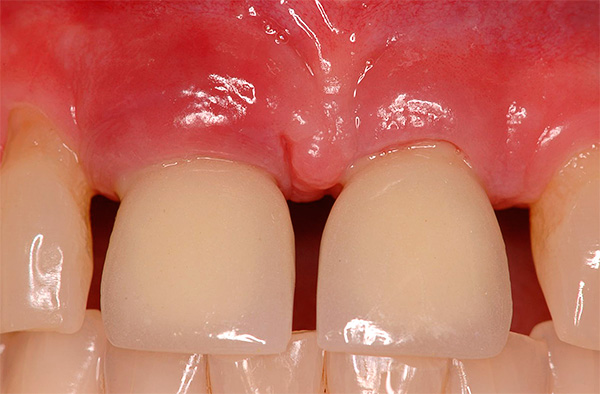
Why are dental implants sometimes rejected?
There are not so many reasons for rejection of dental implants in general. In most cases, the problem occurs by mistake of the doctor during the procedure. Much less often - when choosing a poor-quality or even fake implant (again, this can also be considered a medical error).
But the patient should not relax - because of the peculiarities of the state of health or if certain rules of behavior are not observed in the rehabilitation period, tooth implants may also be rejected. Symptoms of the onset of rejection in almost all cases will be the same, regardless of the causes that caused them.
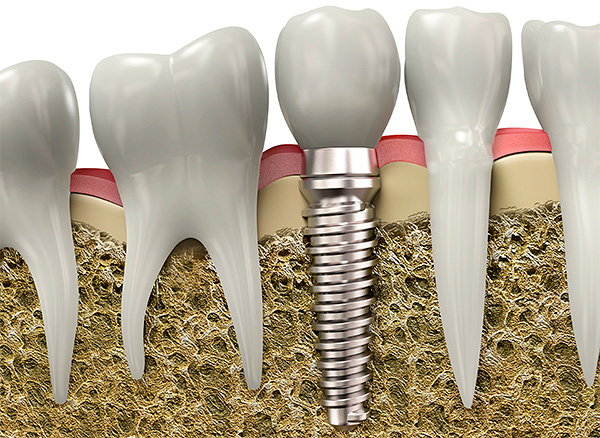
Consider the possible causes of the problems in more detail.
First reason: unprofessionalism or a doctor’s mistake
A characteristic feature in this case is that the implants begin to be rejected immediately, that is, during the engraftment period.
Unfortunately, dental implants are most often rejected precisely because of medical errors - this may be a lack of experience, especially when faced with complex clinical cases, unprofessionalism, or simply ordinary carelessness.
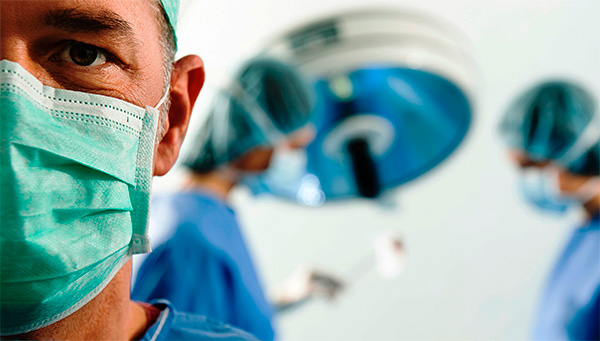
Here, for example, what mistakes an implantologist can make when working:
- improperly selected implant design - for this reason, the implant may not be able to properly fix in the bone (for example, it may be noticeably longer or thicker than the bone tissue);
- lack of sterility of the working tool or working area in the oral cavity (foci of acute inflammation have not been eliminated) - as a result, an infection is initially present in the wound;
- tissue overheating when drilling holes for an implant;
- improper positioning of the implant in the jaw;
- lack of sufficient information about the patient’s health status - possible contraindications are not ruled out.
Of particular difficulty for the doctor is the lack of sufficient bone tissue to fix the implant (for example, due to its atrophy) and acute inflammatory processes.
The problem of bone atrophy can be solved by replanting it or by choosing a method of basal implantation, in which implants of special design are used, which are fixed in the deepest basal parts of bone tissue. However, rejection of basal implants can also occur at any stage of engraftment. According to statistics, they have to be removed no less than classical implants.
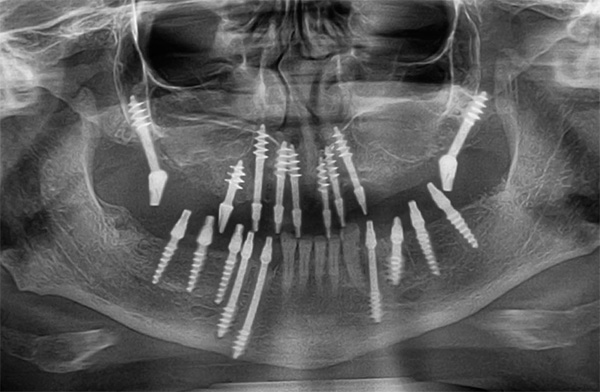
On a note:
Periodontitis and periodontosis implantation, that is, against the background of acute inflammation of the gums associated with the destruction of bone tissue, it is quite possible today. But far from all implantologists will decide to install implants in the presence of such inflammatory processes.Basically, a similar procedure is carried out simultaneously with the removal of a diseased tooth, and after implantation of implants, drug therapy is prescribed with simultaneous enhancement of oral hygiene.
With rejection of implants due to acute inflammation of the jaw tissue, repeated implantation is not always possible due to severe destruction of the bone.
The second reason for possible rejection: poor implant
Large dentists work with dealer networks that supply implants directly from the manufacturer, which eliminates the possibility of getting fakes. In small clinics, the situation is more complicated.
The photo below shows an example of corrosion of a poor-quality implant:
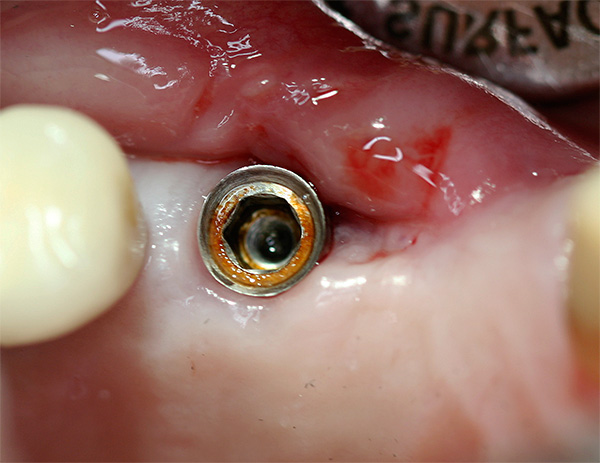
The quality of the implant itself also plays an important role: the more expensive the system, the more advanced materials and technologies are usually used in the manufacture of the structure. Large implant companies have large budgets to spend on improving products and developing innovative technologies.
It is interesting:
The quality of engraftment, and hence the risk of possible rejection, largely depends on the material the implant is made of (it must be titanium biocompatible with our body), as well as on the features of its surface. Today, many manufacturers prefer a porous coating - growing cells of the jawbone penetrate into it, which ensures strong bone and implant fusion.
Third reason: patient irregularities
In this case, the symptoms of implant rejection can occur both during the engraftment period and after a few years of using new teeth.
It should be borne in mind that even if the doctor conducts all his work on installing the implant perfectly, improper subsequent actions by the patient can negate even the best treatment result. What you need to pay attention to first of all:
- Do not load the implant during the engraftment period;
- overheating and hypothermia of the body in the first days after the operation is prohibited (that is, you can’t go to the bathhouse or dive in ice water - all this can weaken the immune system to some extent);

- there is no need to hide existing health problems from the doctor - this can be life-threatening, although you yourself may think that these problems have no relation to dental implantation and you can be silent about them;
- if the doctor prescribes, then it is necessary to take drugs against implant rejection in a disciplined manner - the means prescribed by the doctor can accelerate the healing process and minimize the risk of peri-implantitis;
- it is necessary to take care of new teeth - brush in the morning, in the evening, remove food debris after eating (for some it seems that these are artificial teeth, they “do not rot” and do not need to be taken care of - and this is a big mistake);
- It is highly advisable to give up bad habits - in particular, not to smoke.
On a note:
Practice shows that smokers reject dental implants much more often than non-smokers. According to statistics, about 30% of smokers have symptoms of rejection within the first five years after surgery. As a result, the implants have to be replaced with new ones.
Toxic resins and nicotine lead to malnutrition of the cells of the mucosa, which negatively affects the condition of the tissues around the implant. Ultimately, the design loses its stability, becomes mobile, torn away by the body.
The question is: what should smokers do? The choice is not very large - either refuse implantation, or reconsider your lifestyle - stop smoking (or at least smoke less).
The fourth reason for rejection of dental implants: poor health
This reason leads to rejection of implants mainly a few years after their installation.
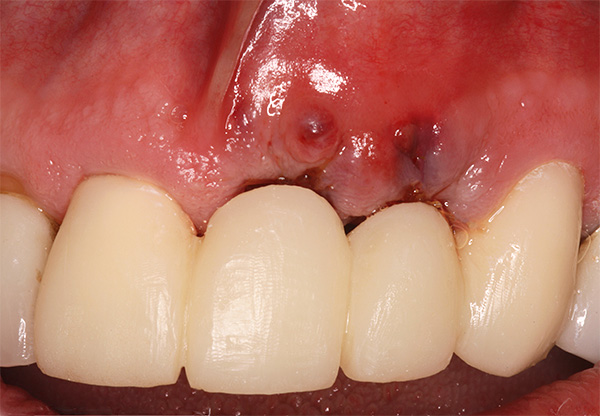
If the implants were not rejected in the first two years, then we can safely talk about the success of the treatment.But a problem can arise many years after the installation of structures. This is extremely rare and mainly due to either mechanical injury, or an exacerbation or development of certain diseases: cardiovascular, diabetes, immune (AIDS), tuberculosis or cancer.
What to do if inflammation starts under the implant?
When there are alarming symptoms of the onset of inflammation in the area of the installed implant (there is a smell from under the implant, pain, redness of the gums, swelling, etc.), the only right decision will be to immediately consult a doctor. The implantologist will conduct a visual examination of the state of the installed implant, do an X-ray examination, and if necessary, open the gum and help cleanse the wound from pus.
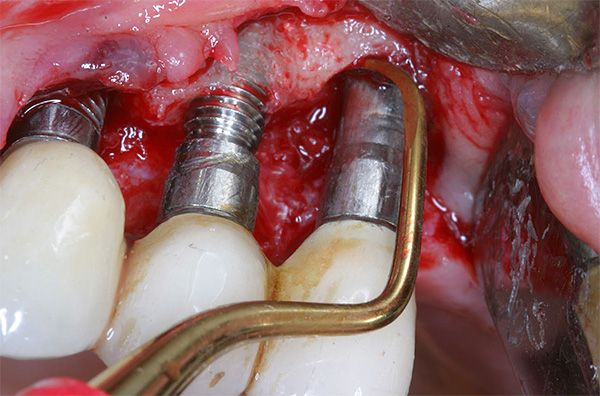
If problems began during the period of engraftment of the structure, then sometimes the cause of unpleasant sensations (for example, putrid odor from the implant) can be easily solved by temporarily unscrewing the plug of the implant and cleaning its outer surfaces.
But in the presence of obvious signs of peri-implantitis, in most cases, removal of the installed implant is indicated, and this must be done as soon as possible. Indeed, otherwise, running inflammation can lead to the spread of infection throughout the body, which is fraught with very serious consequences, up to the threat to the life of the patient.
In addition, the longer inflammation is observed in the area of the implant, the more the bone tissue around it is destroyed, and the more problems there may be in case of repeated implantation.
Is repeated implantation possible after implant rejection?
Re-implantation is possible in most cases. It should be borne in mind that after removal of the rejected implant, no more than 1-2 months should pass - otherwise the bone tissue, without receiving the proper load, will gradually atrophy.
If necessary, bone marrow transplantation can be performed and drug therapy may be prescribed to suppress infection in the focus of inflammation. After the restoration of damaged tissues, repeated implantation is performed.
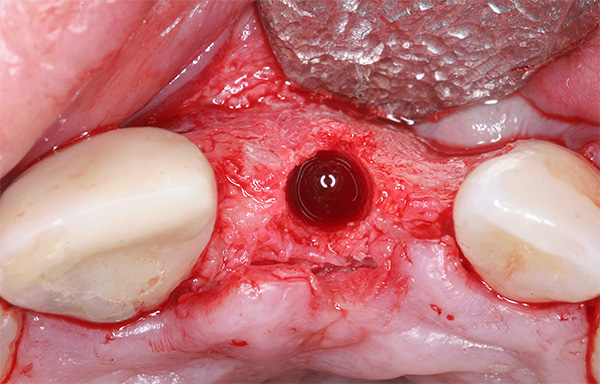
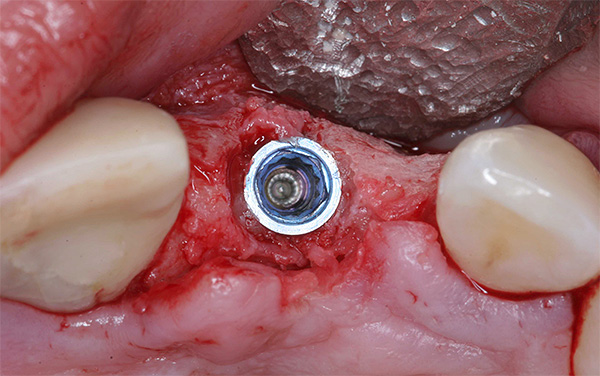
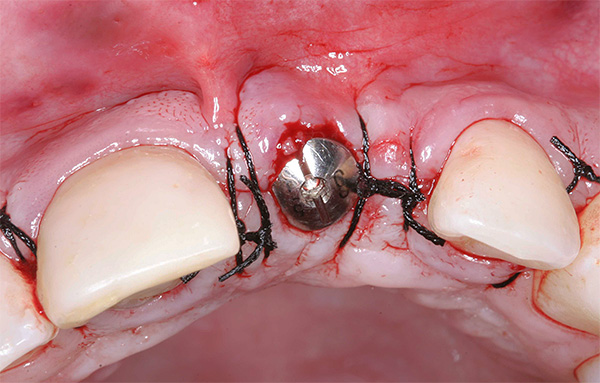
On a note
According to the law, there is no guarantee for surgical work, so the patient will have to rely on the consciousness of the administration of the clinic or the doctor, who will fulfill the independently established warranty obligations. The long-term or unlimited guarantee for implants, which is established by manufacturers of constructions, is just the life of artificial teeth. But whether they will serve the declared years - it depends on the patient and the doctor.
How can you protect yourself in advance from possible problems associated with implant rejection?
In conclusion, it is worth bringing a few useful tips that will minimize possible problems associated with rejection of installed implants.
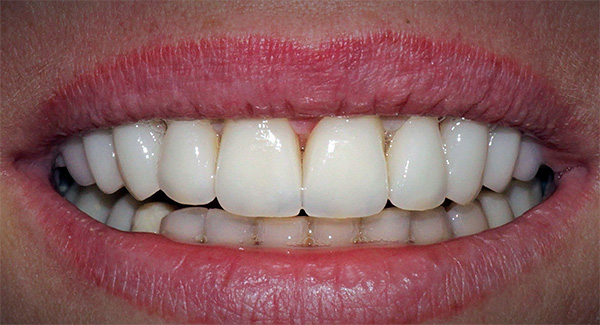
So here are these tips:
- you should be aware in advance that the responsibility for the result of the treatment lies not only with the doctor’s shoulders, but also with you (an undisciplined patient who does not follow the doctor’s instructions can ruin the results of even the most jewelry-filled work);
- choose a clinic with a “name” - as a rule, large centers invest in modern equipment and staff training;
- choose a professional doctor with experience and positive recommendations and reviews (the choice of a doctor is more important than choosing a clinic);
- give preference to high-quality implants - not lower than the average price segment (you should choose well-known brands that have existed on the market for at least 5-7 years);
- comply with all the requirements of the doctor after surgery and monitor oral hygiene;
- and, of course, do not forget to regularly undergo preventive examinations of the oral cavity, timely treat diseases of the teeth and gums and take care of them daily.
In general, the risk of falling into the number of patients whose implants are rejected is minimal. It is much more likely that they will serve you faithfully for decades, if not a lifetime.
An interesting video about the complications that may occur during dental implants
What to choose after all: implantation or crowns?

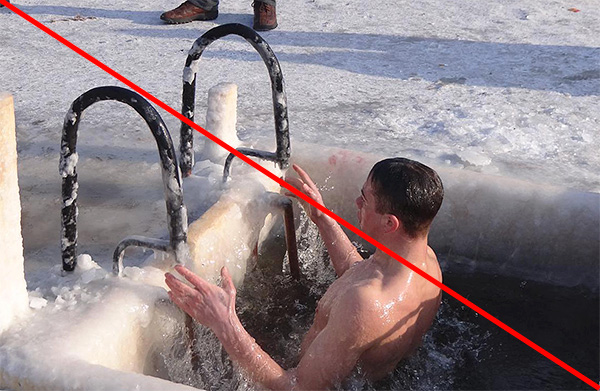
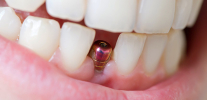

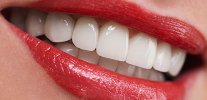
Not 2 years have passed. A mini implant of the upper jaw causes pain and swelling in the wing of the nose and cheekbones in the maxillary sinuses. The prosthesis removed. What to do?
Hello! You need to contact an experienced implantologist urgently. Make computed tomography. Judging by the description, the mini implant became mobile and could damage the bottom of the maxillary sinus, pain in the wing of the nose indicates this. If my suspicions are confirmed, then the implant will need to be removed and the inflammation removed. And after removing the threat of the spread of infection, see how to restore your teeth. Personally, I do not recommend the installation of mini-needle implants, since they do not have good primary stabilization in the bone, it simply cannot be achieved due to the structural features of the product itself. The prosthesis, as a rule, incorrectly distributes the load, which leads to the mobility of the implants and serious damage to the bone tissue around them. Often, such implants are rejected and “fall out”.
After implantation in the upper jaw 3.4 teeth, when expectorating from the nasopharynx, a sucrose appears. The time after implantation is three days. At the doctor’s appointment, remove the stitches after four days. What to do, go to the doctor sooner?
Good afternoon, I don’t know if you had a sinus lift operation, or if the implants were installed immediately (in the latter case, the maxillary sinus floor could really be damaged). Consult a doctor better now and have a CT scan to see what’s going on. Bloody discharge from the nasopharynx is a sign of complication. I hope you strictly followed the doctor’s instructions after sinus lift, if there was one. The patient should not rinse his mouth in the nasopharynx for 3 days after the procedure, do not hark, do not blow your nose, try not to sneeze, drink through a tube.
Hello, Doctor. I had implantation 11 days ago with simultaneous bone growth. The seams have already been removed.
1. Swelling was and lasted a week. Now in the gum, where the implants stand, a barely noticeable swelling, to the touch is noticeably distinct.
2. At first, it bleed for several days, then it was replaced by some discharge, the color was yellowish-white. At the moment, they are still there, little by little out. My implantologist says that this is bone tissue, i.e. bone formations.
3. The edges of the gums are slightly raised, and the adjacent tooth aches when tapped on it.
Questions:
1. Are the periods of edema normal under this condition and how long can they last? 2. The discharge described above is a normal process and how long will it last? 3. Is everything all right with the gum and tooth?
The implantologist-author says that these are all normal processes, I want to believe, but, as they say, trust but verify.
Thanks in advance for your reply.
Hello!
1.Swelling and pain is a normal occurrence after a sinus lift operation, as a reaction to tissue injury. May last up to 10 days if the area of injury is large.
2. Discharge can not be called the norm, but here you need to more clearly know the clinical picture of BS, to accurately state. It’s hard to say when this will stop without an examination.
3. The fact that the adjacent tooth aches is normal and will pass over time. Some time passed and not all tissues were rehabilitated.
If you want to accurately check whether everything is in order, contact another doctor - today many clinics provide free consultation. When choosing a doctor, try to find a person with experience, preferably an implantologist, periodontist, or ChLH.
Hello, I have an Israeli implant, installed 5 months ago. Around the implant are formed, as the doctor called them, bedsores, he says that such a process is possible if many years have passed, but not 5 months. When the gum shaper puts, then it is sick to press on it. For the last couple of days, for some reason, the shaper itself was twisted out, and I had a feeling that it was squeezing out. I will push him there, and after a while he climbs out. How does implant rejection occur?
Good afternoon. If there is pain in the area of the implant when biting and pressing, then it is highly likely that you have already started the process of peri-implantitis. But without a snapshot, here you can’t say 100%, this is a hypothetical answer. Regarding the gingiva former, an examination is also needed. It is possible that the shaper is incorrectly selected, or it is not sufficiently twisted. We can definitely say that the behavior of the shaper is not typical.
I recommend that you urgently consult a doctor and do a CT scan to study the condition of the bone tissue in the area of implantation and, if necessary, take timely measures to suppress inflammatory processes.
A week passed after the basal installation, a painful bump appeared under the chin. What is it?
Hello, Niall. After implantation with immediate loading, phenomena such as swelling or bumps in the chin area are possible, but very rare. However, do not be afraid that the implant may tear away. Since the basal implant is polished and placed in deeper parts of the bone tissue, the likelihood of problems with it is very low. Perhaps this is a reaction of the body (more precisely, the surrounding tissue around the implant), manifested by a densification of the periosteum.
I recommend that you contact the doctor who installed the implants for an examination. I also advise you to do computed tomography of the chin section and make sure that there are no serious changes in the form of rarefaction of bone tissue around the implant.
There was implantation a week ago, tonight the temperature rose 37.3. They placed 5 implants, around two gums they are still swollen and blood oozes from under the formers. The surgeon is on vacation and will be only in a week. What to do is not clear, there is no second implantologist in the clinic.
Hello, Tatyana! The recovery period after surgery can take up to 3-4 weeks and includes slight discomfort. In some patients, during this time, some soreness and swelling of the postoperative region remains.
Now in your situation you need to contact any dentist (preferably not wait for your own), regardless of his specialty. That is, in fact, you can contact any dental clinic for an examination in the oral cavity and, possibly, for computed tomography (CT), the results of which will help you understand the true cause of your symptoms.
I would also recommend focusing on improving oral hygiene, as against the background of a decrease in local immunity after surgery, one of the causes of complications is often poor cleaning of the oral cavity. If the temperature does not drop, and the blood continues to go, then most likely the installed implants were infected. Since your doctor will probably be back from vacation by then, you will need to contact him immediately.
Hello. Installed implants, 5 and 6 below. It hurt for 7 days, then calmed down. After 10 days, the stitches were removed, the surgeon said that everything was fine. 3 days after the removal of the sutures, severe pain began. The whole jaw ached, it seemed that all the teeth were inflamed: both above and below. They took a picture, opened 4-ku next to the implant. The pain continued. The pain was already in the neck, under the jaw and gave in the ear. A day later, the implant was removed. On the second day after removal of the implant, the pain was gone. Now everything is calm. The image showed that the implant abutted against a nerve. They tell me that the reason is in the tooth, not in the implant. Could it be?
Hello Jasmine! In such a situation, it is usually necessary to conduct a CT scan and evaluate the position of the implants delivered relative to the mandibular canal, since the complaints you voiced are really characteristic when the mandibular nerve compresses (compresses) the implant. It happens that doctors install implants close to the nerve - in your case this is a likely option, as evidenced by the departure of pain after removal of the implant
The neighboring tooth, most likely, was not the cause of the pain, however, for an objective assessment it is important to see the whole picture: the results of the X-ray examination and the data obtained during the examination of the oral cavity.
On August 27, 2016, two implants were installed at the bottom and one at the top, but just at the bottom, one of the implants, under the canine, in the lower jaw. The next day, the lips began to go numb and the right side of the lower jaw, where this implant is located. And also the swelling is even greater than on the first day. 08/27/2016 baths were appointed: baking soda with iodine in warm water, ciprolet 500, 2 tablets per day, physio - ultrasound and magnetic, and phototherapy with a Zepter apparatus. They said that healing can last a month. The picture was taken on August 29, they said that it was a good picture. But swelling and numbness of the jaw do not go away. No pain, I don’t complain about the other 2 implants.
Hello! After the installation of implants, this is possible, it all depends on the quality of the work performed and the body's response to traumatic intervention and foreign materials. As for numbness, this is either damage to the nerve passing in the lower jaw along the canal (extremely rare), or compression of the same nerve trunk (most often) by exudate (hematoma, edema). I can’t say for sure, your doctor is better informed about this. In principle, judging by the appointments, I can’t say anything bad: more than in full.
It goes without saying that healing after implantation can be delayed up to a month or more. I think that the edema will pass faster than numbness: just a week has passed, most likely, it is already much better on sensations. Numbness can go away for a long time: it all depends on the listed possible causes of its development. Most often lasts 2-3 weeks or a month, less often - up to 6-12 months. I don’t know if I’ve been encouraged or not, I recommend that you find out the details from your dentist, let me honestly explain what and how - at least according to the pictures of the location of the implants in relation to the jaw canal.
Good afternoon! Today is the 6th day, when 6 implants were installed on the upper jaw with bone grafting (sinus lift). I have had bad breath for two days now. I asked the doctor, he said that this is normal. Thanks in advance for your reply.
Hello! I think that the unpleasant smell is associated with a violation of hygiene due to the fear of harming the implants. Recommendations that most often occur after implantation:
1. Adequate oral hygiene using a toothbrush with soft bristles and a minimum amount of paste (2-3 times a day);
2. After eating, as well as after brushing your teeth, it is important to rinse your mouth with an antiseptic prescribed by your doctor or with a special rinse aid at least 3 times a day.
The return of the proper level of hygiene after implantation will create conditions for the disappearance of an unpleasant odor. Be sure to consult with your doctor individually for the selection of an antiseptic for the oral cavity and rinse aid.
The main thing is in no case to consider your condition after the placement of implants far from normal life. There is simply a list of appointments and some rules that make life as comfortable as possible. Thanks for the question.
After surgery, it is really necessary to pay great attention to oral hygiene, since any food coating on your own teeth or structures that are in the mouth can cause an unpleasant odor.
Since there are a lot of bacteria in the oral cavity, and soft plaque is food for them, then after surgery it is recommended to brush your teeth or dentures, despite the painful sensations. If the installed implants do not bother you, then most likely the reason is precisely the low level of hygiene.
Good afternoon! Tomorrow I’m signed up for an implant, but today I have a runny nose and a sore throat. Is it possible to ignore them, or first let the cold go away?
Hello Svetlana. Installing an implant is an operation, and it is recommended to carry it out at a time when you are completely healthy. The fact is that immunity after surgery will be reduced, and against the background of a cold, the risks of developing local complications increase. I recommend you to fully recover and only then come to the operation.
Hello, I have pus under the lower front tooth implant. Asked the doctor to remove the implant, he refused, said that it could be due to a disease of the duodenum. Is this possible? Thanks in advance.
Hello! For me personally, such a connection is doubtful, although some diseases often lead to rejection of the implant, especially if the implantation technique is violated. I think that the doctor’s tactics are not entirely correct here. If you have the opportunity to get another consultation in the chair of a doctor who is engaged in implantation in your city, then this is important to do as quickly as possible. Without seeing you in the chair, now I can only assume that the treatment is not quite on the right track.
Hello, Jazgul! In the situation described by you, removal of the implant is usually recommended, since its porous surface is already infected. However, an objective final assessment can be given only after computed tomography and subsequent examination of the oral cavity.
Of course, general somatic diseases of the whole organism can affect the condition of the dentofacial system and soft tissues of the oral cavity as a whole, but in your situation, the causes of purulent discharge are local factors, such as infection of the wound during surgical treatment or poor hygiene. It is highly doubtful that a disease of the duodenum could somehow affect the situation. We strongly recommend that you contact a specialist as soon as possible.
Hello! Six years ago, I had two tooth implants placed in my left upper jaw. For a month now they have been staggering and bleeding. The smell is unpleasant.Should I go to the dentist? There is no implantologist in the village. There is no way to go to the city where they were set.
Hello! According to your description, it looks like signs of implant rejection, almost 100% - peri-implantitis. It is necessary to consult a dentist to clarify the diagnosis. Unfortunately, the fact that there is no implantologist in the village may not leave another option (if you do not go to the city), except after making a diagnosis related to rejection of the implants, remove them in the village where there is a dentist surgeon. And then - plan a trip to the city (you can even go to another specialist in the field of implantation) and put in either implants or use an alternative prosthetics option (for example, to make a bridge or other, it all depends on your situation in the mouth). If there is an orthopedic dentist in the village, then instead of implants, you can perform simple prosthetics. I don’t think that you can guarantee a second implantation under warranty, although 6 years is not a long service life for high-quality modern implants.
Hello Paradise! It is necessary to consult a dentist-surgeon for an examination. The symptoms you describe are similar to peri-implantitis, when the implant becomes unstable due to infection and atrophy of the bone tissue around it. I advise you to remove these unstable implants in the near future, so as not to aggravate the situation of bone loss. It is necessary to preserve bone tissue as much as possible. Then, after removal of the implant, it is necessary to wait time for its restoration and complete healing of the wound - this is at least 4-5 months. Then re-do computed tomography and assess the condition of the bone tissue. Only after this is it possible to draw up a new treatment plan.
Two implants for 4 teeth (upper left) sank into the sinus, the sacrum, painful sensations. Where to find a specialist?
Hello, Vladimir! Judging by the situation that you are describing, inflammation in the left maxillary sinus is now observed. The reason for this, most likely, was implants - I suppose that against the background of their overload there was a bone resorption (decrease) around the implant and subsequent inflammation. Overload arose due to the small number of implants on a large number of chewing teeth. Patients with problems of this kind often come to our clinic. Each case is individual, and you need to study the whole picture in order to correctly diagnose and to solve the problem with the highest quality.
At the current moment, I can say that you need an implant surgeon and an orthopedist. Together they can help you.
Hello. On the 3rd day after the implantation of two front teeth, I got swelling, my eye swam and had a bruise ... Near the implants, there was something white, like pus. The palate was stitched, and also chased. What to do? The doctor said that swelling is normal. I injected intramuscularly demictasone.
I drink amoxiclav, I brush my teeth gently, after eating, rinse with chlorhexidine. Swollen more left side, to the eye.
Hello! There are swelling after implantation, but with the spread of edema described by you, it does not hurt to get advice from another maxillofacial surgeon to exclude possible complications. I don’t see the point of contacting the attending physician, since his opinion is already clear - he considers the spread of edema “under the eye” to be a normal state. According to the information you have indicated, I can’t tell you anything additional now, since careful examination in the oral cavity, determination of the state of tissues during palpation is required, it is possible that X-ray control is required.
Thank you for your reply, and for your participation to me. My edema was asleep, there were slight bruises, yellowed.Inside the oral cavity, everything is slowly recovering. Today is the 7th day after implantation, the other day I’ll go to remove the stitches. Thanks again, all the best!
Hello. During the installation of the implants, I had a hypertensive crisis, pressure 200/120. They took me to a cardiology center. The doctor said it was a reaction to anesthesia. 2 months have passed, now the doctor is afraid to continue working with me. Advise what to do? Thanks. I am hypertonic and have vascular atherosclerosis 60%.
Hello, Larisa! Situations of this kind are not uncommon. Against the background of general psychoemotional stress and the use of an anesthetic containing adrenaline, blood pressure always rises. And since you have hypertension and vascular atherosclerosis as concomitant diseases, this already suggests that you cannot perform surgery only under local anesthesia. It is necessary to use sedation.
Sedation is not anesthesia, but the so-called potentiated analgesia, when they use special drugs that enter into a state of slight prostration or superficial sleep (nap). That is, you will remain conscious, but will not remember the moment of the operation. In this case, you will carry out the doctor’s commands while in a relaxed state. It is comfortable for you and for the doctor. After this, the joints do not hurt, the muscles do not hurt, and the operation can be performed within 3-4 hours. During the procedure, the anesthetist also introduces an antibiotic, antihistamines and anti-inflammatory drugs. He constantly monitors your condition. In this case, the doctor who operates is focused on the operation.
Also, consultation and a conclusion on the authorization of the operation from a physician and cardiologist will be necessary. You may need to adjust the regimen of some drugs that you are taking.
Hello. In March, they installed an implant in place of the top four. There, the bone was atrophied, and I had an implantation together with sinus lift. Almost a year has passed, but now my implant is completely felt through the skin, as if there were no bones there (this is on the front side). My doctor will be only in January. In connection with these questions: is it possible to plant more bone tissue from this side, without touching the implant? And if you don’t touch, then will I not be left without an implant? When pressed, nothing hurts yet. I gave a lot of money, went to the best clinic in the city, and this happened ((
Hello! I would recommend doing dental computed tomography (VCT) to understand the cause of this problem. Without a snapshot, it's hard to blindly advise anything. We can assume the vestibular installation of the implant, that is, this means that the implant was oriented significantly towards the outside and the wall was thin. That is why resorption of the external cortical plate could occur - and, as a result, now the structure is felt on palpation. It is necessary to look at the degree of bone resorption (in some cases, it is better to reinstall the implant). Again, only the doctor can make the final decision after examining the situation during the examination.
Hello. I add that if the implant is really palpated through the gum (if I understood correctly, “through the skin”), then this is an absolute indication for the revision of the implantation zone, during which the implant's stability, its degree of exposure and the possibility of its closure with bone material are evaluated. It is possible that the implant will need to be removed. An audit should be carried out in the near future, as the situation may worsen over time - then the chances of maintaining the implant will decrease.
Hello. I got an implant seven days ago. And the gums are still swollen.There is a little white spot, like an abscess. Tell me, please, is this normal?
Hello! I do not think that your description falls into the category of norm. I recommend the following procedure: consult your doctor for advice. If the implantologist determines the problem and makes a correction of the treatment, then all that remains is to wait for positive results. If the doctor begins to assure that this is normal and will not take any actions, then it is advisable to get advice from an independent doctor who is engaged in implantation in another clinic. I understand that in a commercial environment, sometimes not very professional doctors begin to criticize the work of a previous specialist without good reason. But in this case you will definitely feel it. Be that as it may, without a detailed examination of the condition of the surrounding gingival implant, it is difficult for me to draw conclusions on how dangerous this is. It is better to play it safe and get a full-time consultation.
Hello. I agree with a colleague. In general, the situation of a purulent fistula is described, which indicates the presence of an inflammatory process around the implant. Urgently see a doctor.
Hello. I got an implant 20 days ago. They removed the seams. All is well. But today, the implant became visible in the gum a little, before it was not visible. I press on it slowly - I hear a crunch. And I began to feel the implant itself. Tell me, please, what does this all mean? So it should be?
Hello. Week 3 is one of the critical moments in the process of implant osseointegration. Judging by the description, in your situation, the implant has lost contact with the bone, has become mobile, and gradually comes out. Most likely, it will be necessary to remove it and plan a second implantation. It is important to check with your doctor as soon as possible.
Hello! She installed implants on the lower jaw. Bone material was added, a membrane was placed, and sutures were made. Exactly a month has passed. A few days ago I noticed some white crumbs, they are hard, they grit on their teeth. Come out of the hole in the gum from the side of the lower lip. Run to the doctor? Is this bone material coming out?
Hello! Judging by your description, there is reason to believe that there is a fistulous passage on the gum, through which bone material enters the oral cavity. It is too early to say that the implants have not taken root, but I recommend that you contact your doctor as soon as possible, since the situation does not apply to the normal state.
Hello. Perhaps in the area of bone grafting there is an inflammatory process, because of which the integrity of the barrier membrane is violated. Therefore, the granules of bone material go into the oral cavity. It is urgent to consult a doctor to resolve the issue of revision of the plastic zone.
I was examined by a doctor and asked him a question about these white crumbs. He said that everything is normal, there is an excess of bone material. He advised putting Solcoseryl Dent constantly, until everything heals. In principle, now these crumbs are almost gone.
I forgot to ask the doctor, maybe you can say: sometimes there is a pulsation in the gum in the implant placement area - is this normal?
Hello! Not sure if this symptom is the norm. However, symptoms should be confirmed by examination in the oral cavity + radiography data. If you have a fistulous passage in the implant area in your mouth - this alone is a matter of concern + you are talking about pulsation, which also confirms suspicions.
Hello! Tell me please. I am 29 years old.On December 2 (2 months ago) implantation was performed in the region of 13 tooth (fang) on the upper jaw. There was swelling of the cheeks, it hurt terribly. After 5 days, a small lump appeared on the gum, closer to the nose, and increased in size. After the doctor pierced her, i.e. a week after implantation, fluid started to flow out, pain and swelling subsided. The doctor prescribed a laser, the gum practically did not hurt, only with strong pressure, but pus slowly flowed out of the gum. They took a picture, the implant takes root well, there are no blackouts, there are no pains either, but pus appeared in a small amount when pressing on the bump and flowed down the front wall of the gum and came out to the side of the implant pin, or it is not clear on it ...
When this bump appeared, drank antibiotics, rinsed betodin, water-salt-soda. 2 times did plasmalifting of the gums, a little pus stood out, but, of course, less than before. The cone resolved, but the pus came out from under the pin on the side ... Before the new year, the doctor put on a plastic crown, but left a place for the pus to drain (the implant itself was installed a little obliquely, i.e. at an angle - as the doctor explained to me, where there was more bone ) Of course, I feel better, but when pressing on the gum from above, closer to the nose, a small amount of pus is still released. In the crown area, there is no redness or pain, redness at the top of the gums, closer to the nose. The only thing - pus disturbs, although not in large quantities.
Please tell me, is the allocation of pus talking about peri-payment? 2 months already go with inflammation ... But when tapped, the implant does not hurt, does not stagger, does not bleed. What should I do in this situation? Wait for pus to stop going? Or it’s better to remove it now and try again later, but I don’t know if I will decide again ... Sorry to be so detailed. I'd love to hear your opinion ...
Hello. Such a period of suppuration indicates the presence of chronic inflammation in the area of the apex of the implant. Most likely, its tip comes out of the bone in the nose and is located under the gum. To clarify this situation, it is necessary to do CT (computed tomography), and not OPTG (panoramic image). If so, then the implant must be removed. If the tip of the implant is in the bone, but there is darkening around (according to computed tomography), then it is necessary to consider the possibility of revising the area of the tip of the implant.
Hoping for an independent cessation of suppuration is not worth it. I recommend getting an in-person consultation in another clinic with an implantologist who can give an independent assessment of the problem and conduct a thorough analysis.
Hello. Two years ago, implants were placed on the upper jaw, 5 pieces, all in a row. For weeks two, a mild aching pain is tormented, and when walking or jumping it gives back to implants. Sensation - as if they were knocking on them from the inside. There are no redness or swelling. Please advise what this condition can produce and is this not related to the onset of rejection? Thanks.
Hello! This may well determine the onset of the inflammatory process, so it’s worth taking pictures and consulting with your doctor. It’s too early to draw final conclusions, but it’s worth it to be safe - the sooner you seek diagnostics, the more chances you can get out of this situation with the least losses.
Hello, Svyatoslav Gennadievich! Since November 2016, she began to prepare for implantation: she cured everything that was needed, at the end of January they removed the figure of eight at the bottom left, the removal failed, the tooth crown broke off and the doctor drilled the root. Healed for a very long time, a sharp piece came out from the side of the tongue, it hurt and injured the gum. The doctor bit him off. The wound has not yet dragged on. 02/17/2017 performed the implantation of the 4th and 5th tooth in the lower right and the 6th and 7th left.Today is 02.20, everything is calm on the right, there is no pain, no swelling. Pain on the left, I don’t understand why - either from implants, or from an unhealed wound on the gum from "biting off" a bone. The gums in the area 6 and 7 of the implant and in the area of the removed 8 are red and swollen. Today, the doctor filed a wound in the figure eight (a white bone was visible). He says that the pain from this wound, with implants everything is in order. With pressure on the gums, the 6th and 7th implants are painful, there are no discharge. The implants on the right have neither pain nor swelling. Is the doctor right? I'm afraid of inflammation.
Hello! I think that the doctor was very likely to be right in noting the inflammatory process near the eighth tooth as the cause of the problem. When the bone tissue is exposed, there can even be very severe pains - this seriously violates the normal healing of the hole. Therefore, the doctor did everything necessary to eliminate this problem. As for the pain in the area of the newly installed implants: within 1-2 weeks, pain with pressure on the gum in many cases may well be present, and this is not considered a pathology.
How to understand the mathematical inconsistency in the article in two citations:
“On average, implants are rejected in no more than 3-5% of all cases, and indicators vary greatly depending on the brand of designs. For example, German or Swiss-made implants successfully take root in 97-98% of cases, and more affordable Israeli or Russian-made products - in about 95%. ”
“Practice shows that smokers reject dental implants much more often than non-smokers. According to statistics, about 30% of smokers have rejection symptoms within the first five years after surgery. ”
1. Exaggerated percentage of successes?
2. Exaggerated the harm of smoking and the number of unsuccessful cases in smokers?
3. 98% is the percentage of engraftment in the first 1-2 years, and 30 percent of rejection is the percentage of rejection after a long period (5-10 years)?
Hello! Percentage of successes is an approximate general statistic. There are also survival statistics for specific types of implants.
For smoking - the risks definitely increase, especially among hard smokers. But to calculate exactly how many cases are unsuccessful is difficult, since each clinic has its own ways to deal with this problem. Recently, at the appointment, I had a patient with implants who, for their sake (or rather, for the amount that he gave), had not smoked for about 2 years. Then he lit a little again - and came to me.
In general, you should not look only at the percentages given: for each patient, the dentist will determine his level of risk. With normal hands of the doctor and patient adequacy (the desire to cooperate with the doctor), the probability of successful implant engraftment will be about 98% in the first months, and this percentage will decrease slightly if you look at it even for a decade. Otherwise (for example, if the doctor’s recommendations are not followed, with poor oral hygiene, malicious smoking), the risk of complications increases by 5-10 years.
Before placing implants on the lower jaw, the bridge of 7.5 implants on the upper jaw was uncemented. The doctor cut the gum for a larger landing bridge, there was severe pain and temperature. Doctors held out for four months while they were doing the bottom. A pocket appeared at the notch, and everything was festering. But doctors blame the implant and say that it must be removed, as if it were inflamed. But he stands firmly, and did not get sick, but just uncemented. After cleaning, there is now a sharp pain and, probably, you will have to remove the implant. Can I expect a doctor to correct my situation? Or can I prove nothing?
Hello! Generally speaking, in dentistry it can be difficult to prove the fact of a particular manipulation. Firstly, because in the medical documentation with a high degree of probability the doctor described everything as it should and should be according to the protocols of this type of treatment. Secondly, the dispute procedure, including the creation of a medical commission that studies the pictures before and after, the state of the oral cavity, etc. - The matter is also troublesome and paid. However, if you find a common language with the doctor, then you can always agree amicably. Otherwise, you have the right to apply complaint mechanisms to his superiors, indicating their readiness to assert their rights. But, as far as I know from the unofficial statistics of Russia, the evidence base is always going to be difficult, and during its collection the documents in the clinic are polished to the ideal. And the doctor, if it starts to smell fried, as a rule, is fired, often in hindsight. The medical organization itself finds many loopholes to hush up this situation.
After installing two implants in the upper jaw, 6 months passed. Established gum formers. Gums ached. When the abutments were screwed into one of the implants, there was pain during screwing. It has been 10 days, and when pressing on the implant, dull soreness is felt in the depths. The gums around the implants ache when pressed. 2 days ago we installed a removable denture on the buttons. When chewing, pain is not audible, but sometimes there is nagging. Could this indicate peri-implantitis?
Hello! Symptoms are sluggish in order to 100% say about the onset of reimplantitis. And the evidence base is always based on x-ray data and examination of the gums with implants. It may be that during the “twisting” the gum was simply injured, but otherwise, it should take a little time to understand whether it turned out well or not. It seems to me that the doctor could not help but call you for control in 1-2 weeks (or in a month) to determine the quality of implantation. In this case, let him guide you on the treatment schedule, and you can safely tell him your fears so that after diagnosis, examination and analysis of the situation, conclusions are drawn and treatment is adjusted (if necessary).
Put 2 implants down on the chewing teeth. One implant quickly took root, and the second swayed a little, but there was no pain. Slight swelling. The doctor said that the last tooth did not take root. They redid it, again unsuccessfully - it touched the nerve and there was a hematoma (half of the lip was numb and it seems that the tooth comes into the tooth). The implant was changed again, but the sensations did not change - just as dumb and large swelling. It’s impossible to even swallow, such pain when swallowing.
I put the implant 2 years ago, on the canine. Pus comes out over the fang on the gum. I drank antibiotics, the discharge decreased slightly, the implant does not stagger and does not hurt. I want to remove it and forget about implantation, put a crown, is this possible? Thanks.
Good afternoon, yes this is possible! But I recommend to be examined by a qualified specialist and find out the cause of suppuration. I would not recommend removing the implant, if possible. If the implant needs to be removed, then it is better to reinstall it later. Bridge prostheses lead to big problems in the long term: to install a prosthesis, you need to grind adjacent healthy teeth, and this is their serious and irreversible damage. In addition, if you want to remove the implant, you will need to replenish the bone tissue, otherwise the gum under the crown of the bridge will sag quickly and the aesthetics will be impaired, moreover, atrophy will lead to the mobility of adjacent teeth, and the entire structure will not last long.
My opinion: the installation of a dental bridge instead of an implant to replace 1 tooth in this situation is impractical neither from the point of view of the effectiveness of treatment, nor from the financial side. But it's up to you, of course. I only insist not to drink antibiotics without a prescription. It is necessary to identify the cause of suppuration in the implant with an experienced specialist and, if possible, to save the work done.
Thanks so much for the tip. Was with other doctors, the problem is not in the implant, it is next to the tooth on which the crown is worn, inflamed. We treat.
Hello. 5 days ago, I installed the “all on six implants” system. Until the prosthesis was installed, the pains were weak, the swelling, of course, was strong, but there were no bruises. Two days ago, they “screwed” the prosthesis. Now a constant aching pain, giving way in the ears. I don’t live without pills. It seems that the doctor tightened the nuts. In the process, I told him that it hurt, but he said that he should pass. However, it does not pass. He was on vacation, before leaving, he did not pick up the phone, although he called more than once. It shoots in the ears, in the jaw crushing and bursting pains. But ears and throat are more worried, as it is not strange. There is no smell, but the sensations are very similar to a toothache, and the whole jaw hurts. What is it?
We took an aim picture of two implants during the installation of the prosthesis. Can there be pains from too tightly twisted connecting between the implant and the prosthesis nuts? The edema is almost gone, but there is a strange and painful seal in the front lip. I drink an antibiotic, rinse after each meal. Honestly trying to clean, but it really hurts!
And yet, the prosthesis was installed on the third day after the operation, without removing the sutures, and the jaw was literally tightly screwed on barely revived after removal of implantation, suturing and other associated pleasure.
Ears and throat are very sore. Why?
And the second one. When drawing up a treatment plan, the doctor assumed Adi implants at the appropriate price, and set the Instant. But for some reason this did not sound to me. And they are much cheaper, IMHO? Is it worth arguing? And is there a chance to achieve the truth?
I'm worried about your ear and throat complications. As I understand it, prosthetics took place on the upper jaw. If zygomatic implants of the Zygoma type were used as part of the All-on-6 complex, then it is likely that the implants were not installed correctly. As for implants from Medent, I am not familiar with them. Adin implants are known, but in our clinic we do not use them for a number of reasons.
An aim picture is not enough to understand the picture, you need to do a CT scan. You can send a snapshot to the site’s mail, I will comment. Also, if you wish, you can sign up for a free consultation with me.
Concerning the brand of implants installed - of course, it is worth arguing, since you should have installed exactly the brand of implants for which you paid. All data must be specified in the contract.
Thanks for the answer. I implanted the bottom) It took 7 days, all the appointments were completed, but the pains (especially nightly) remained. Today I thought I would live without a pill, but I realized that the very body of the gum, on which the prosthesis is mounted, is very sore and shoots the bones in such a way that it is not clear - is it an ear, throat or implants? .. Is it like a fresh stump of a hand, For example, they put a prosthetic arm. In the ear shoots. If she could, she would have removed the prosthesis. Very painful!
This is normal? I was at an appointment in this dentistry - my doctor is on vacation, so another doctor looked at me. She said that everything is fine 🙂
I don’t live without ketanov! Interestingly, you have to drink it all your life? I was not warned about this ((
Good afternoon! If implantation is performed on the lower jaw, then the symptomatology of pain is similar to trigeminal neuralgia. As I wrote to you, I highly recommend doing a CT scan in an independent laboratory.CT results in the event of further clarification will greatly help you.
If the nerve is damaged is not critical, then over time the pain can pass on their own.
Do you have numbness or a feeling of anesthesia somewhere?
No, there is no numbness. I understand that from the fact that the gum body hurts, everything starts to hurt. Or I don’t understand anything that hurts me 🙁
Yesterday I contacted a doctor from the clinic where I was operated on, said to take diclofenac and miramistin. Miramistin replaced with chlorhexidine, I drink diclofenac. Today I’ll stop by to see me. I don’t know when these pains will end ...
Good afternoon! I have an adentia of the upper jaw, many teeth were removed about 15 years ago, I have been wearing a full removable denture for more than 5 years. A recent CT scan shows bone deficiency throughout the upper jaw, the surgeon said (and I don’t know how much is left). I really want to make implantation, but there is a “bouquet” of diseases, among which are: chronic glomerulonephritis (kidney function preserved, disease experience 35 years), grade 1 hypertension, stage 2, risk 3, tachycardia, arrhythmia, carotid arteriosclerosis, stenosis of the left carotid artery 40%, hypercholesterolemia, multinodular goiter, eutheriosis, osteopenia, vitamin D deficiency, etc. Thyroid hormones are normal. I constantly take calcium channel blockers and statins. I am 46 years old. I ask you to answer the question: with such a “bouquet” of diagnoses is it possible to carry out implantation (the general practitioner gave a conclusion about the absence of contraindications). And is there any hope that implants will take root? And is it possible to count not on a removable denture on implants, but on a pretty bridge? Thanks in advance!
I forgot to indicate that I am still allergic ((Glucosamines, some vitamins, food allergies.
Good afternoon! One of the most non-traumatic methods of implantation with immediate loading of Basal Complex may be suitable for you, or in another way - basal implantation of teeth. If your therapist reports no contraindications, then implantation can be done. But first, I need to get acquainted with computed tomography (CT) and the state of the oral cavity. And also to study your medical history in more detail.
It is important to choose the right method of anesthesia in your case. You can probably count on a “nice bridge”, the prosthesis is fixed for 2-3 days after implantation, and you can start using new teeth almost immediately, gradually increasing the masticatory load.
If you wish, you can make an appointment with me for a free consultation. If you do not have a CT scan, then it can be done in a clinic. Please capture the therapist’s opinion.
Good afternoon. Tell me, please, the situation is as follows: 4 days ago they put implants on the left side, 2 upper 1 lower. After the operation, there were no serious symptoms for several days. But she began to notice that a living tooth standing nearby began to hurt when pressed and stagger a little. And today, the nose has been blocked on the same side as the implants, and when blowing, dense snot with blood comes out.
Is this the norm, or urgently need to go to the doctor? At the stitch removal appointment, I only need 1.5 weeks later.
Good afternoon! In any case, you urgently need to go to the doctor and take a control picture, to understand the nature of the mobility of the adjacent tooth in the lower jaw.
“Snot with blood” is, of course, a suspicious symptom, but it may not be of a dental nature, especially if you have not had sinus lift and implants installed outside the maxillary sinus.
Hello. Please explain why, after installing the healing abutment on a normally implanted implant, inflammation occurred? When the doctor screwed it in, I felt pain as I penetrated deeper. Maybe this is a wrong gingiva shaper?
Good afternoon, inflammation could occur due to damage to the soft tissues and microbes entering during the installation of the gingiva former. It may be worth unscrewing the shaper and reorganizing the area, reinstalling the plug on the implant and waiting for tissue rehabilitation, and then go through the shaper installation step again. If the shaper was “non-native” (from another system of implants), then during its installation, damage to the implant in the bone could occur - for example, different threads in the internal cavity of the implant and strong doctor pressure when trying to screw the shaper. This could also lead to an inflammatory process.
You need to look at the picture and the area of inflammation. If possible, you can sign up for a free consultation with me, I will look and say more precisely the reason and what to do next.
The day after implantation, swelling, pain, and a low-grade fever arose. I began to rinse with salt and soda, drink ibuprofen and an antibiotic. We have 3 days off, so I could not see the doctor. Is it possible to install crowns on such an implant? And why did inflammation occur?
Good afternoon! The crown cannot be installed immediately after implantation according to the two-stage protocol. The fact that edema occurred immediately after installation is a normal occurrence, but a rise in temperature above 37 is a bad sign. Perhaps, for some reason, inflammation has occurred around the implant - you definitely need to see a doctor urgently. The measures you have taken, in my opinion, are quite justified for the weekend, but even if the inflammatory process is stopped, the doctor still needs to show up, reporting his problem.
After complete implant engraftment, a crown will be installed, and a new tooth will serve you as a native. The presence of an inflammatory process (stopped on time) does not mean a negative outcome of the entire implantation.
Hello! After removing the 4th upper tooth (with a cyst), an implant (Nobel) was immediately placed ... The implant was not sick at all, but after 2 months there was inflammation away from the implant, and often there was aching bone pain at one point, periodically swelled , gums on the 1st, 2nd and 3rd teeth inflamed. The doctor claimed that everything was fine and he did not see anything.
I did a CT scan, on which the doctor also did not find anything, but said that if he continues to hurt, he will have to remove the implant. When he began to remove, the implant fell out easily, i.e. I was not going to take root at all from the very beginning. It would seem that the inflammation has been removed and the cause has been established, but the pain in that same place has remained, and the entire gum in the area of healthy teeth still swells periodically. The doctor is extremely annoyed and thinks I'm making it up. Please comment on the situation.
Good afternoon! 4 tooth is located in the maxillary sinus, inflammation can occur if you have problems in it. You write that the doctor watched a CT scan, but did not find anything, and, judging by your impressions, the implant did not take root. It all looks pretty weird. Nobel implants (original) are very high-quality products, and with proper installation, the percentage of rejection is almost zero. Those. in this case, it’s not worth sinning on poor-quality implants.
The following possible reasons remain:
1. The infection, when the cyst was removed, spread to neighboring areas in the bone tissue (it cannot swell without an inflammatory process);
2. When installing a dental implant, there was damage to the periodontal tissues of the neighboring teeth - sometimes doctors screw the implant slightly at an angle, and it is important to ensure that the artificial root does not damage the tissues of neighboring living teeth.
3. Or you have inflammation in the maxillary sinus, which gives complications.
Hello.Three teeth have been removed recently, I want to install implants now. I read about various companies on the Internet - they write that some implants can take root in different ways due to different coverage. Is it so? Does anything else affect the implantation of implants of different companies? I would like to know the opinion of experts. Thanks in advance for your reply.
Good afternoon, first of all, the implant survival depends on the doctor’s qualifications and on how the patient complies with all appointments and instructions after implantation. Regarding the brands of implants - yes, indeed, there are differences. My opinion: you need to choose time-tested implant systems, for example, Nobel Biocare, Straumann, Xive, AstraTech, Bio Horizons - they belong to the premium category. From the budget category, I would recommend MIS, Osstem, Simpl Swiss.
“They write that some implants can take root in different ways due to different coverage” - that’s absolutely true, that’s why implantologists usually work with several implant systems, and not only for financial reasons, but also because for different clinical cases (in particular, an important indicator - the state of bone tissue) there are different requirements for the thread, shape and type of implant placement.
Hello! Tell me, please, if the cheekbone implants do not take root, then they are twisted back? Thanks.
Good afternoon, yes, in this case there will be a reinstallation of the zygomatic implant with a wider thread in the same bed, or according to the indications, the penetration vector may slightly change.
Hello! She installed the implant two months ago. They immediately made a plastic crown on it. After the installation, there were almost no unpleasant sensations, but I drank antibiotics on prescription. Now I have become pregnant, the implant does not bother, there are no painful sensations. But the redness around the implant does not pass and lasts for 2 months. The doctor said a reaction to the plastic crown is possible. Please tell me, is this possible? And what should I do if I'm pregnant?
Good afternoon, yes, your doctor is really right, an allergic reaction to plastic is possible. Since 2 months have passed, you can change the crown for a permanent one. But first, it’s worth removing it, observing the gum reaction and making sure that everything is normal with the implant. You did not write which implant system you were given - some systems achieve stabilization in 2-3 months, and you can already install a crown made of zirconium dioxide or cermet.
An important caveat: all these manipulations can be performed after 1 trimester and under the strict supervision of your gynecologist. Much depends on your condition during this period. If pregnancy is difficult, I recommend not to resort to prosthetics, but simply to remove the crown and carefully care for the implant.
Good afternoon. Two upper implants were installed yesterday, one of which is in the hole from the tooth just removed. I had to pay 10 thousand for the material for bone growth, because the hole was wider than the implant itself. At night I woke up from the sound of a crunch at the implant site. I drink antibiotics, there’s no pain anymore. The crunch did not repeat. Should I be scared of this sound and run to my doctor?
Good afternoon, often people grit their teeth hard during sleep (for some even this is a disease called bruxism). Crunch is most likely due to excessive stress on the implant and artificial bone. I highly recommend seeing a doctor and taking a control shot.
Recently, an implant fell out, placed 7 years ago. What do you think could be the reason? Hygiene is always carefully monitored.I think the matter is not in the implant itself, because for seven years there have been no problems.
Good afternoon, Elizabeth. It is difficult to answer your question without having to inspect the oral cavity and not having pictures on hand. Perhaps a mistake was made when the tooth was included in the jaw row at the stage of prosthetics. The crown should be precisely selected according to the bite, that is, fit snugly against the opposite teeth (be in contact), both at rest and when chewing. This ensures an even distribution of the load on the implant. If the orthopedic design (crown) is improperly made and installed, the implant can be overloaded, which can lead to its destabilization.
It is also possible that there are some more serious reasons - for example, bone disease (the process of rarefaction led to a loss of implant stability). There may be many options. If you send a snapshot (to the site’s mail), I could analyze it and comment in more detail.
Good afternoon! On November 15, she removed 8 teeth on the upper jaw. Assigned to drink the antibiotic flemoxin solutab, 250 mg, take one 2 times a day for 5 days.
After that (on November 23), she installed implants in the upper left jaw: 5 and 6. Slightly increased the bone from above, sewn up and immediately installed the gingival shaper, placed the dentium implants, appointed to treat with chlorhexidine and smear the dent's metrogyl, and if there are pains, then take 1 tablet of arkoksia once a day. Antibiotics have not been prescribed since I took them recently.
Now is the third day after implantation, and only on the third day there were small swelling (the gum was swollen from the very beginning). The pain is the same aching. There was a little blood while processing the dent's metrogil, but it soon passed.
My question is: is everything OK with me and should I start taking antibiotics?
Hello Olga. Edema often increases by the third day, and this is normal. The pain can persist for up to 3 days, then if the pain persists (does not decrease), you should agree on the possibility of resuming antibiotics with your doctor in order to avoid the development of infection and accelerate the regeneration processes after surgery. Also, be sure to follow all the recommendations and continue monitoring with the implant surgeon on a regular basis.
I had 4 implants placed on the upper jaw along with the installation of bone tissue (since it was not enough). It's been over 2 weeks now. The swelling and bruising are gone, but my numbness bothers me. The doctor said that it will pass. Sutures have not yet been removed. What advise me?
Hello, Catherine. It is necessary to control this situation with the help of computed tomography, as well as undergo an examination by an implant surgeon and make sure that the implants are installed correctly and that the nerve is not affected. If everything is done correctly, then the sensitivity will soon return. Possibly, there is a slight compression on the peritoneal tissue - this can also cause numbness in certain parts of the face.
Good afternoon! After installing 2 implants and sinus lift on the upper jaw, a month passed. Swelling of the cheeks (noticeable) lasted about three weeks, but there was no pain. Now the seal on the gum is very dense, but painless along the entire length of the implantation. 3 and 7 teeth were implanted. Could this be a displacement of bone material? The doctor took a picture and said that everything is fine, it is a dense swelling. A week after implantation, the submandibular lymph node was inflamed, the cytigran antibiotic drank - everything went away. My age is 57 years old.
Hello, Nina Nikolaevna. Continue to observe the prognosis of your treatment in the absence of pain is favorable.And about the displacement of bone material - here you can answer only if you have computed tomography. Judging by your message, the doctor has already done this. Edema was asleep - this is a good sign, the tissues can really thicken, and then the edema resolves.
Thank you, Bulat!
The implant sways after 10 years. The most expensive German set at that time. Pain when biting. Will you really have to change everything?
Hello Alla. Biting pain is a bad symptom, it is likely that it is peri-implantitis. In this case, the implant is removed, an operation to restore bone tissue is performed, after which a second implantation can be performed. But it should be borne in mind that the situation may also be associated with the prosthesis - it is possible that a screw has been loosened that fastens the implant with the crown, and now it causes pain when biting. In this case, the screw can be relatively easily reinstalled. Be that as it may, in any case, an examination by the implant surgeon and orthopedist is necessary with additional control over the image.
Hello! 03/20/18 installed an implant, 4 on top. On day 3, she seemed to the doctor, everything was fine. A day later, the cheek swelled (swelling almost to the eye, and very dense at the level of the nose). I went to the doctor, according to the doctor - the 5 tooth got inflamed (when you touch it, pain occurs). He made cuts, squeezed out pus. Prescribed antibiotics: Flemoxin Solutab, 500 mg (2 times a day) + rinse your mouth with soda solution. The next day, everything was unchanged, a dense painful seal in the cheek as it was, and remains. Tomorrow remove gum and seams. My worries about edema, it does not go away. What do you advise?
Hello. The occurrence of purulent inflammation in the area of implantation is always a risk that the implant does not take root. In most clinics, before the operation, an oral cavity sanitation (dental treatment) is mandatory to minimize the risk of the situation that you have.
Since the abscess was opened, and adequate therapy was prescribed, it can be expected that the edema will disappear in a few days (do not worry that the edema did not disappear the next day - the resorption process can take up to a week). However, even despite this, it is important to completely treat the 5th tooth so that the implantation zone does not become infected further.
Hello. They put an implant on my lower jaw, it took root and they put a gum shaper on me. There is no way to finish the operation. Today I noticed blood when rinsing my mouth (from the place where the implant). Tell me, can it be a rejection?
Hello Alina! Minor bleeding is possible if the wound is still fresh and 2-3 days have passed after the shaper was installed. However, if the shaper has been installed more than 3 days ago, then the bleeding that has arisen is alarming - in this case, it is important to see a doctor who has an implant as soon as possible (reinstallation of the shaper may be necessary). It’s premature to talk about rejection of the implant by only minor bleeding.
Good afternoon! 2 months ago, an implant was placed in place of the sixth tooth, in the lower jaw. After implantation, nothing hurt, but I regularly took all the drugs. Neither a gum shaper nor a crown have been installed for me. A week ago, in the area of the 8th tooth, on the same side where the implant was installed (in the lower jaw), a purulent spot appeared. I do not have an eighth tooth and did not have one at all. The area where the implant is installed is neither sore nor red. Please tell me, purulent education may be associated with poor implantation?
Hello Anastasia! The cause of purulent formation in the region of the 8th tooth may be, for example, chronic inflammation in the region of the roots of the 7th tooth. To clarify the situation, I recommend contacting a dentist-surgeon and making a computer tomography of this area for an accurate diagnosis.
Hello. They installed an implant three years ago. Everything has taken root perfectly, the only thing after installing the crown hurt in this area for about 1 month. And then all the time, while the crown was standing, there was a feeling that food constantly fell between the crown and gum. I could not clean it out, since the implant was deep - I just couldn’t reach it with the flos.
After 3 years, a constant aching pain occurred at the implant site (lateral incisor). The gum is in order, although it has slightly risen above the crown from the side of the sky (the abutment is bare for a couple of mm). When pressed, pain does not intensify. Pus, odor, etc. not. On a panoramic image and CT scan, everything is fine (as the doctors say).
The doctor removed the crown, unscrewed the abutment and installed the shaper (to see what would happen). After that, for 2 weeks in the place of the implant (or gums) there were very severe pains. Gradually, the pain decreased, but are constantly present. Tell me, please, what to do? Doctors offer to remove the shaper so that the gums are overgrown, and then we'll see. An implant removal option is not considered. I’ve been tormented for 5 months.
Hello, Alexander. There can be several causes of pain in the implant area, and first of all it is necessary to carry out differential diagnostics - to determine which of the entire installed implantation complex is the cause of pain. If the cause of pain is an implant, then, unfortunately, measures will have to be taken to remove it. However, in most cases, the implant can be maintained with timely treatment. I recommend that you contact another implantologist (not the one who has already examined, and better from another clinic in general) - for an independent diagnosis and decision-making on further treatment.
Hello! A month ago, they installed 2 implants on top of me. When biting and tapping implants it doesn’t hurt, but when you press the gum it hurts. What could it be?
Hello, Oksana. Pain in the gums can be, for example, a consequence of the inflammatory process. Here it is worth considering how implants are carried out - if the gum shaper is already installed, that is, there is a risk that small particles of food get between it and the gum, as a result, a pocket is formed. In this case, it is necessary to undergo an examination with a doctor as soon as possible (in the future, it will be necessary to improve hygiene). In general, I can say that postoperative observation is one of the most important components of the treatment process. Your doctor should regularly monitor the condition of the implants, and if there are any problems, then take steps to solve them.
Hello. 8 months after implantation. After complete adentia, a prosthesis was installed on the upper jaw using technology all at 6. One of the implants, a little to the left of the nose, pulsates. He went to the doctor, took a picture several times - everything is normal in the picture, there are no inflammations around. They made a prosthesis freely, so as not to press on the gums - it did not help. They say that everything is fine with you, but the ripple as it was, it is. And this is not a gum, the ripple was always after installation, I just always hoped that it would pass. How to be
Thank you in advance for your reply.
Hello, Vladimir. Complaints of a sensation of pulsation in the implant area 8 months after installation are a rarity. If a full-fledged diagnosis was carried out and the measures taken by the doctor did not help, then to clarify the situation, you can try to additionally turn to 1-2 additional independent specialists (preferably from another clinic). If you have consulted more than one doctor, and no one could help, then there is only 1 obvious option - removal of the implant with subsequent reinstallation.
3 days ago, three teeth were removed on the lower jaw on the right and implants were immediately placed (it turned out through one tooth).I take anticoagulants and I said this (more than once) to the dentist and implantologist. Swelling gradually subsides, but a large hematoma with swelling of the lip does not go away. I do all hygiene procedures and take drugs strictly. The swollen lip is a little bloody, because it comes in contact with the tails of the sewing material, and there are a lot of tails, I feel it with my tongue. The husband installed the implants several years ago and the sewing material was self-absorbable. They sewed me up, in appearance - a thin fishing line.
What should I do besides prescribing a hygiene doctor and laying Solcoseryl Dent so that the hematoma resolves? She looks dark, like a birthmark, and underneath is a dense tissue. My doctor believes that this is not scary. It is not possible to lay Solcoseryl between the lip and the jaw, they are on the same plane. I'm afraid of tissue necrosis.
Hello Vera! In the postoperative period, a hematoma can really form in the area of surgical intervention - especially since you are taking anticoagulants. So this is a kind of norm option. At the moment, you must clearly follow the doctor’s recommendations and conduct regular monitoring. The doctor's recommendations should indicate anti-inflammatory, antihistamines and antibacterial drugs.
As for the Solcoseryl Dent gel applications, they are used to accelerate wound healing, but the hematoma itself is not removed.
In order to avoid undesirable complications, the doctor should carefully monitor the healing process and the safety of sutures. Normally, the hematoma will disappear on its own, and the main thing here is not to try to speed up this process by self-medication.
Hello. 8 months ago, an astratech implant was installed on the front tooth. Has taken root. A month ago they put a gum shaper - they pressed the gum very hard, to the pain, and attached the crown. For a month, nothing bothered, nothing hurt, and suddenly an abscess appeared over the gum.
Why could this happen when gum formation and the presence of a temporary crown, because the implant was placed 8 months ago? Is this a rejection? For a whole month nothing showed up, it didn’t hurt, but here is a small abscess. It turns out that I went for a month with internal inflammation? I am very worried about the implant.
Hello, Lily. It is unlikely that this is a fistula due to the inflammatory process around the implant - most likely, the infection accumulates under a temporary crown, which led to gum inflammation. In such cases, the crown is usually removed and the area of connection of the crown and implant is treated. In any case, you need an examination by a doctor to clarify the true cause of the problem.
Good afternoon. I went to the doctor then, the crown was removed - everyone was rinsed. They said that the gums are slightly inflamed, everything is fine with the implant, food may have gotten into it. The abscess after did not jump out. I went on vacation - and here again jumped out. But in connection with the vacation I can get to the doctor only after a week. Tell me, if food fell under the temporary crown and the gums inflamed again before the formation of the fistula, then what will happen to the permanent crown? Will food also fall under the gums? Will I always be attached to the dentist? Do I need to take a picture just in case? I’m very worried, because I survived more than one operation in the gum area. It is very worrying that all this began after the installation of a temporary crown.
Hello, Lily. From the description alone, it is difficult to make an unambiguous conclusion about the causes of the formation of an abscess. The prerequisites for the occurrence of the inflammatory process can be very different, and in such a situation it is really useful to take a picture (CT). Not the fact that it is the accumulation of food under the gum that leads to inflammation.It rarely happens that a piece of bone material can lead to problems of this kind in the area where the gums adjoin the crown (bone materials are used in most clinics for implantation). So you need to understand the problem in the dentist’s chair.
Hello. I have such a situation. Installed 4 implants on the lower jaw, two on each side, with bone growth. On the one hand, everything is fine, and on the other, from time to time a liquid appeared that looked like pus, but odorless. The doctor said that this is bone fluid, and that's okay. I did not continue treatment, but went on vacation for three months. And all this time, a fistula with this fluid appeared at the same place.
Upon arrival, I went to the doctor - it turns out that 5 months have passed. He put the shapers, first on the one hand (just the problem), then on the other. My lower gum has already sank strongly. And the upper teeth are healthy, but you need to remove the nerves and grind. While I was dealing with this issue, I had implants dropped from the problem side! What is the reason? So, there was already rejection and inflammation, and my doctor wanted to continue prosthetics ?! And is it possible to put the implants back, or is it necessary to again build bone tissue?
I do not know if I can now trust my doctor. There was a problem initially, but he closed his eyes, said that everything was normal ((
Hello Svetlana. Bone material may have been infected during the initial healing of bone tissue after surgery. Not seeing the situation before and after and not having pictures in hand, it is difficult to give an exact answer about the causes of the problem. To say whether a second bone grafting is required, it is necessary to evaluate the condition of the bone tissue during a visual examination or CT scan (or OPT scan).
If you do not trust your doctor, then it makes sense to additionally consult (in person) at least one more specialist. This usually helps to dot all the i's.
A week ago, he placed an implant in the upper jaw. Everything went well, removed the seams. The other day, when eating, food got on the implant - I felt a slight pain. He touched the implant - a little staggered. Will he take root?
Hello, Vladimir. Without a visual examination in the oral cavity and without seeing the images, it is difficult to say for sure whether the implant will take root. Here you need to evaluate how strong the mobility, as well as the condition of the tissues adjacent to the implant. Also, the situation with prosthetics is not entirely clear from the description: did you immediately have a crown installed on the implant?
With significant implant mobility, it usually needs to be removed and reinstalled, but only after a few months (from 2 to 6). I recommend to see a doctor as soon as possible in order to clarify the situation and exclude all possible risks with implant engraftment.
They put the implant a month ago. Is it possible to make beauty injections with hyaluron in the lips and nasolabial folds?
Hello Irina. Cosmetic injections (fillers, Botox, etc.) after implant placement can be done.
Yesterday the implant (6, in the upper jaw) was removed, which was rejected two months ago. Although there was a slight mobility of the implant, I chewed on it normally, so I did not go to the doctor. The doctor said that there will be re-implantation in 4 months, because the hole is large. My question is: why such a long period? After all, implantation is usually recommended after 1-2 months. And why not transplant bone material?
Dear Alexey, hello. 4 months is necessary for bone formation at the site of the removed implant.In 1-2 months, the bone simply does not have time to go through the mineralization phase, which will not allow achieving primary stability when installing the implant. The doctor’s decision not to transplant bone material may also be associated with infection of the bone in the area of the removed implant - this could lead to rejection of the bone augmentate.
Hello. 3 weeks ago, they placed 4 implants on my upper jaw. It seems that it doesn’t hurt, everything is fine, but today my temperature has risen. What could it be? Is there any cause for concern?
Hello Emilia! The temperature rise after dental implantation is sometimes observed in the first 3 days, and this is considered the norm. However, a rise in temperature after 3 weeks is no longer the norm. It is also possible that the malaise is associated with other causes (SARS, for example). To eliminate the connection between temperature and implantation, I recommend contacting your implantologist.
Hello. Six months ago, I installed a basal complex on the entire jaw. Hygiene is good, there are no signs of inflammation and no complaints. But I have a feeling that one of the implants sways (if you touch and put your tongue on the gum in the place where the implant peeks out from under the artificial gum). Can this seem to me? If the implant is still staggering, can it strengthen in the bones in six months, when will the adaptation bridge with crowns be replaced with a permanent one? Or will the implant have to be removed?
Hello Olga. I would highly recommend seeing your doctor. Tell your feelings at the reception to dispel all doubts. You may need to do a CT scan. But in general, the main thing is to attend the prescribed professional examinations and prosthesis corrections, after six months the implant may well stabilize.
Hello. 1.5 years ago, installed the implant on the lower 7 on the left. The implant took root and did not bother for a little more than a year, but the last 5 months it hurts for two weeks, then it doesn’t hurt as much. It hurts both at rest and when chewing food. The pain is aching, throbbing, a little pus comes out when you press the gum, when you floss with a dental floss, there is a putrid odor under the crown. Flossing, rinsing with an irrigator, rinsing with soda - nothing helps.
On an X-ray, CT, and a panoramic picture, everything is in order - there is no inflammation and blackout. The implant does not stagger. When it begins to hurt, then a balloon is inflated from the outside (from the side of the cheek), closer to the 8th tooth (it is with nerves, only the seal is standing, but it does not respond to the hot-cold). The ball hurts when pressed. On the 6th tooth (it is without a nerve) there is a very small inflammation on the root, closer to the 5th tooth. I went to several doctors - everyone says that everything is in order, there are no deviations in either 8 or in the implant, but with inflammation such as 6, they say, they go for 10-15 years.
Tell me what it can be and what to do next? I am very worried that there will be peri-implantitis. And there’s no strength to endure pain.
Hello Maria. In the implant area, all teeth should be treated to avoid peri-implantitis. Therefore, I would still recommend curing the 36th tooth (with inflammation in the root). The putrid odor from under the crown is probably the result of a loose fit (in such cases, food remains are clogged in the gap). It is possible that after the elimination of these two problems, the situation normalizes.
And yes, it is not recommended to use dental floss in the area of installed crowns and implants - only a toothbrush and an irrigator.
Hello, six months ago I installed two implants - 6 and 7, in the lower jaw. After 4 months, crowns were installed.It seems to be all right, but there was some discomfort. The doctor honed the crowns a little bit, saying that this is the pressure from the crowns on the gums. But the problem did not go away, therefore, to understand the reason, the crowns were removed altogether. Abutments stand firmly, do not stagger and do not hurt with pressure. It turned out that at 7 the mucous membrane constantly hurts, which is in direct contact with the abutment on the cheek side, in only one place. And as the pain intensified, I asked already to remove the abutment and see what was there ... The doctor removed the abutment, installed the shaper, and it was so painful that I had to undergo anesthesia.
A week has passed, the pain does not go away. Amoksiklav began to drink, but it remains the same. Implants Osstem. The doctor says that this is not peri-implantitis, since there is no mobility (suggests that it is neuritis). But it bothers me that the pain is localized only on one side, comes from the inside and does not go away ... What could it be? Allergy to metal, or pocket ... I’ve been fighting for 2 months.
Hello, Catherine! In your case, pain can occur for several reasons. The pain may be, for example, a consequence of pinching the edge of the periosteum with an abutment or gum former. Also, chronic mucosal injury is not excluded if the implant was installed on the border of an unattached mucous membrane. I would exclude an 80 percent metal allergy, as well as the likelihood of developing pain due to a periodontal pocket. Be that as it may, a more thorough examination is necessary to clarify the causes of pain.
Hello. A month has passed since I put implants instead of 6 and 7 (with the addition of bone mass). A 5 tooth treated, was inflamed. After removing the sutures, a purulent sac appeared between 6 and 5. The doctor ordered the removal of 5 after 2 weeks. Is he doing the right thing? Maybe this is a problem with the 6th implant?
And how can I check which company implant was delivered in my case?
Hello Albina! Without additional data on hand, I do not exclude that the problem may be with the 6th implant - it is during the first 4 weeks after implantation that it becomes clear whether integration has begun and whether infection is present. However, if the doctor after diagnosis decided to remove the 5-ku, then most likely the problem is still in it.
Regarding the question of which company is the implant: after implantation, the patient should be given an implant passport, which indicates the name of the implantation system, model and size. You cannot (independently, visually, in the mirror) identify the implant without the necessary experience.
Hello! When screwing in the abutment, there was a sharp pain. What does it mean?
Hello Svetlana. Most often, this situation occurs due to the pressure of the abutment on the soft tissues, which causes pain. If pain will occur later, you should make an appointment with your doctor.
Hello. 4 years ago, they installed an implant on my upper jaw. And recently, gum inflammation has begun near him. I think that I myself could injure the gums with dental floss, but I'm afraid that it may be peri-implantitis. How to understand that peri-implantitis started and how to distinguish it from ordinary gum disease due to trauma?
Hello Irina! Inflammation of the gums near the implant is an occasion to immediately consult a doctor. The cause of inflammation will be determined by the doctor after examination and x-ray examination. You cannot distinguish gum injury from reimplantitis yourself.
Hello, I installed an implant on the lower jaw on July 12th. Everything is normal in the implant area.On day 6, white deposits appeared on the tongue, the lip was swollen on the opposite side, and an allergic reaction appeared under the armpit, accompanied by severe itching. I rinse my mouth with miramistin, take citrine for 3 days, there are no improvements.
Good afternoon, Svetlana! The symptoms you describe are somewhat non-standard. In such a situation, it is impossible to remotely give the necessary recommendations, you should consult your doctor.
Hello. 6 months after tooth extraction, implantation was performed. Within three months after the installation of the Israeli implant Uno (seventh tooth) on the lower jaw there were absolutely no complications. When the shaper was removed (to prepare for the installation of the crown), the implant was twisted together with the shaper, at that moment I felt some pain in the bone.
The doctor ordered the implant to be reinstalled after two months, explaining that the implant did not take root, and this sometimes happens. Tell me, what could be the cause of this failure, how to prevent the recurrence of this undesirable situation? No preventive measures were taken to care for the gums, etc. Is there any need to do something to prevent this situation?
Hello, Galina! Your doctor’s tactics are absolutely correct. As for the reasons for the lack of integration of the implant, it is extremely difficult to say here, because Here, the complex of factors immediately plays a role (the implant system itself, the general state of your health, the qualifications of a doctor, etc.). To prevent the recurrence of this situation, I recommend choosing a system of implants from world brands and be sure to monitor your health. Try not to catch a cold and strictly follow the doctor's recommendations in the postoperative period.
Good afternoon. If the implant is removed, is it acceptable to use it for re-implantation?
Hello, Victor. Reinstallation of the implant is clearly unacceptable. The artificial root must be sterile. Sterilization of implants and their reuse is strictly prohibited. During the operation, a new implant must be opened from the manufacturer’s packaging immediately at the time of its installation, and nothing else.
Good afternoon. In 2013, they installed 2 implants in the lower jaw, regularly visited the dentist to check the design. In 2016, she found purulent discharge from under 1 implant, she turned to the doctor who performed the operation. The doctor, having examined without a picture, sent for the treatment of gums to the periodontics office, where they put me in the gums. It helped for two weeks, the described discharge continues until now, sometimes blood discharge is added. Upon repeated visits, the doctor said: what you want, this is an artificial construction, everything can be. In general, nothing is felt, but probably it should not be so? What to do?
Hello, Hope. Of course, normally there should not be any purulent and bloody discharge from under the implant. The indicated symptomatology is similar to the presence of peri-implantitis. To make an accurate diagnosis, it is necessary to make a CBCT and study the condition of the bone tissue around the implant. There may be several reasons for the development of inflammation: an improperly installed implant, an improperly made crown, the presence of inflammation in neighboring areas, and a lack of hygiene in the implant area. So it is necessary to do CBCT and consult a dentist-implantologist.
9 years ago, implants were installed on the upper jaw ... 5 and 7 teeth. Three years, always dull pain. Now you need to do the implantation of the front teeth.I did a CT scan - the picture showed that I have a 2 mm and 1.8 mm perforation of the upper sinus wall. What to do?
Galina, hello. To answer your question, you need an examination and detailed diagnostics directly in the chair. In the meantime, I can only say in advance that the installation of implants with a cortical hook for the sinus bottom by 2 mm is allowed. The cause of the problems must be sought in the individual characteristics of your body.
Hello. Installed 2 implants in the upper jaw. They made a cast. Today I went to try on, when installing the abutment, one implant fell out (almost painlessly). The second stands tight. Why could this be? Thanks.